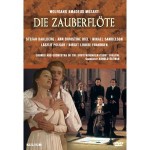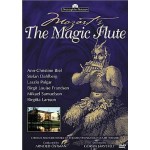Die Zauberflöte
1989, Drottningholm Court Theatre
(Stefan Dahlberg, Ann Christine Biel, Mikael Samuelson, Birgit Louise Frandsen, László Polgár, Magnus Khyle; Drottningholm Court Theatre Chorus; Drottningholm Court Theatre Orchestra, cond. Arnold Östman)
(dir. Göran Järvefelt; video dir. Thomas Olofsson)
This charming small-scale Flute, performed in the same theatre where Ingmar Bergman set his classic film of the opera, is characterized by a thoroughly 18th century atmosphere. The simple wing-and-drop scenery reflects the Europe of Mozart’s time and the costumes are realistic Enlightenment-era garb, with the royal characters and priests in court dress and everyone else in peasant dress. The eclectic bevy of animals that Tamino enchants provides the only hint of exoticism, the story’s supernatural elements are downplayed and spectacle is avoided. But in its place we’re given characterizations of real humanity and, to use an 18th century term, sensibilité. Tamino is no stock fairy-tale prince, but a believable boy on the verge of manhood, friendly, passionate, and brave yet tender: he treats Papageno as a genuine friend and Pamina’s anguish in Act II leaves him sobbing. The Queen of the Night is no aloof goddess, but a wildly passionate woman both in motherly grief and in vengeful fury, as well as a lusty seductress toward Tamino in Act I. The three Boys (sung by women) are an adorably impish trio, not just dei ex machina. Monostatos is no buffoon, but an erotic, truly dangerous figure, and Sarastro is no stodgy sage, but a warm, feeling man, as are his priests.
The singers’ vivid, appealing characterizations compensate for their lack of vocal splendor. Stefan Dahlberg sings Tamino with a fairly plain, grainy sound (albeit warm and firm), but is blessed with an ideally handsome figure and engaging stage presence. Ann Christine Biel, his Pamina, is slightly tart-timbred, but a charming princess nonetheless. Meanwhile, Mikael Samuelson sings with a light and reedy yet appealing baritone and steals the show as a scruffy, folksy, quirky and mischievous Papageno. Birgit Louise Frandsen’s Queen is slightly shrill and lacking in gravitas, but certainly adequate. The performance’s best singing is provided by László Polgár, a dignified, sumptuous-toned Sarastro. The rest of the cast is uniformly good, while Arnold Östman conducts with all the liveliness and lightness of touch expected in a period-instrument performance, his only misstep being the breakneck speeds of the Queen’s two arias. Like several other noted conductors, he transfers the “Soll ich dich, Teuer” trio to the beginning of Act II. Camerawork and sound are excellent, though the theatre’s pseudo-18th century lighting (electric but designed to resemble candlelight) appears slightly dim and muddy on DVD.
This Flute is definitely one of my top recommendations for Mozart lovers. For an opulently sung version, or one full of spectacle and fantasy, look elsewhere, but for a Flute with Old World charm, an authentic 18th century feel, and that treats the characters not as fairy-tale archetypes, but human beings, look no further.
Production Clip: “Hm hm hm” (Samuelson, Dahlberg & the Ladies)





